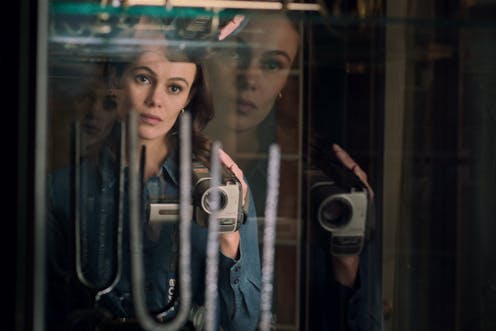horror's love affair with the 'found footage' technique
- Written by Sarah Baker, Senior Lecturer Communication Studies, Auckland University of Technology

In 1999, the low-budget The Blair Witch Project[1] changed the way horror film was shot with its use of “found footage”[2]: a technique that up until then was largely seen in cult films.
The innovative use of “real” footage created a trend that continues to influence film and TV, with Netflix capitalising on the attractions of found footage horror with its critically acclaimed Archive 81[3].
Archive 81 pushes the style further, creating an innovative form that changes the use of found footage. The show is broad in its use of horror, the narrative covering a demonic cult, a pan dimensional god called Kaelego and supernatural mystery that bends space and time. It is the use of found footage that cements the various horror/thriller themes in the program.
The eight-part TV series was adapted from the popular 2016 horror podcast[4] of the same name, created by Dan Powell and Marc Sollinger.
The story is centred on Dan Turn (Mamoudou Athie), the sole film archivist hired to restore a collection of old video tapes that previously belonged to PhD student Melody Pendras (Dina Shihabi), whose story begins in 1994. She is recording an archaeological documentary investigating the strange occurrences in the Viser apartment building, which was built over an old mansion that burned down in the 1920s.
The footage Melody collects is of an unexplained and tragic fire that happened in Dan’s youth, killing his entire family, which connects the two stories in a continuous interweaving of past and present time.
As Dan becomes increasingly desperate to satisfy his own desire for resolution on his family’s death, Archive 81 blurs the timeline between past and present, pulling the audience into the narrative through the intertwining use of found footage.
Found footage and archival horror
While found footage in horror is not new, the genre has been in decline in recent years. The 1980 cult horror Cannibal Holocaust[5] was often claimed to be the first example of found footage in horror, while the Blair Witch Project (1999)[6] popularised found footage as a powerful cinematic device.
For many, the Blair Witch Project presented horror through the lens of the real, captured with the new portable video recording devices of the time, and with a sense of low indie feeling horror. This style of presentation was linked to the new way of promoting film in the internet age, with one of the strongest online marketing campaigns[7] ever made. In 1999, its promotion through the internet and word of mouth was a trailblazer in using the online space.
Hype was created through targeted uncertainty among the public, deliberately confusing potential movie viewers about whether the story was fiction or documentary. Was the footage real? Were the people featured actually dead? The marketing only served to create more uncertainty – even to the point of the filmmakers handing out missing persons leaflets.
Read more: The Visit and other 'accidental' horror films[8]
The Blair Witch project cemented found footage in the horror genre, with other films such as Paranormal Activity[9] following in its footsteps.
In found footage, it is the characters who “record” the drama in amateur style, which is shaky and uneven at times, lending a sense of realness that other horror does not have. That sense of realness is enhanced because the footage documents the narrative, the growth in suspense, terror and horror.
Cloverfield[10] (2008) was praised by critics for its cinéma vérité-style[11] narrative, which earned US$172 million worldwide, with only an initial budget of US$25 million. The film, ostensibly developed from footage from a personal camcorder, includes cuts to older saved footage of the lives of the characters, before a catastrophic disaster hits.
Form and narrative
In Archive 81, the use of found footage is used to innovate form and narrative. Using both found footage and conventional cinema techniques, it blends these seamlessly, moving the story forward and back in time.
The series almost fetishises old recording technologies — from Hi-8 videotapes, to 8mm and 16mm prints, to equipment as obscure as the Fisher-Price PIXL 2000 camera.
Archive 81 is a successful new entry to the horror genre and uses the found footage to set up a dual narrative that eventually connects together. In this way, Archive 81 pushes the found footage horror sub-genre further than previous examples with its complicated and narratively enthralling shifts in time.
It creates an unconventional viewing experience for horror fans – one that will no doubt spawn more new ways of using found footage in future horror films.
References
- ^ The Blair Witch Project (www.nytimes.com)
- ^ “found footage” (foundfootagecritic.com)
- ^ Archive 81 (www.imdb.com)
- ^ 2016 horror podcast (www.archive81.com)
- ^ Cannibal Holocaust (www.imdb.com)
- ^ Blair Witch Project (1999) (www.imdb.com)
- ^ strongest online marketing campaigns (thinkmonsters.com)
- ^ The Visit and other 'accidental' horror films (theconversation.com)
- ^ Paranormal Activity (www.imdb.com)
- ^ Cloverfield (www.imdb.com)
- ^ cinéma vérité-style (www.britannica.com)

















